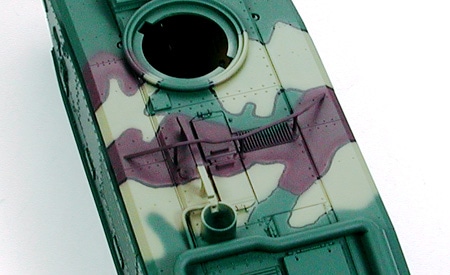1/35 Military Miniature Series No.282
1/35 FRENCH BATTLE TANK B1 bis
In May 1940, B1 bis tanks stood in the way of German armies determined to strike a crushing against France on her own soil. Introduced as an upgraded version of the original Char B1, which was developed in the nineteen twenties, the B1 bis entered production in 1937. The rivet-joined hull mounted a short-barreled 75mm howitzer, while a small, one-man turret carried a longer-barreled 47mm tank gun. The B1 bis was one of the most heavily armored tanks of its time, with plating that was 60mm thick in places, more than capable of defending against anti-tank fire such as that from 37mm Pak guns. The B1 bis could more than hold its own against individual German tanks, and was greatly feared by enemy soldiers who encountered it.
About the Model
★1/35 scale assembly model of the French B1 bis ★Realistically depicts tank's tall profile, 75mm gun and side armor panels covering suspension mechanisms. ★Hull parts are made using slide molding and feature accurately depicted hex bolts. ★Newly-designed track parts require no cement to assemble and snap together easily by hand. ★Commander's and driver's periscopes are moveable, as is the 75mm main gun. ★Choice of two types of fenders and exhausts, combined with 4 sets of markings allows construction of each possible combination. ★Includes realistic metal tow-chain, and 1 tank commander figure. ★Comes with colorful painting guide and four types of marking decals. ★Reverse side of painting guide features an exciting article about the exploits of B1 bis tanks facing German Panzers
B1 bis Camouflage Painting Guide
Between the outbreak of WWII in 1937 and the fall of France in 1940, the B1 bis tank was produced by a number of different makers, and featured a variety of camouflage patterns. Here we will offer detailed instructions on how-to paint one of the schemes illustrated on the color painting guide included with the kit.
How-to Guide
*Note: the Steps in this guide differ slightly from those outlined in the instruction manual. This guide will explain how to paint the tank belonging to 3rd Company, 6th Combat Tank Battalion, 4th Armored Division.
Between the outbreak of WWII in 1937 and the fall of France in 1940, the B1 bis tank was produced by a number of different makers, and featured a variety of camouflage patterns. Here we will offer detailed instructions on how-to paint one of the schemes illustrated on the color painting guide included with the kit.
How-to Guide
*Note: the Steps in this guide differ slightly from those outlined in the instruction manual. This guide will explain how to paint the tank belonging to 3rd Company, 6th Combat Tank Battalion, 4th Armored Division.
-
 2. Olive Green Base Coat
2. Olive Green Base Coat
Paint completed hull and turret in olive green. Paint inside of turret rear hatch in Flat White. If tank is going to be built with hatch in open position, it is a good idea to temporarily affix the hatch in closed position using masking tape from the inside. This will enable you to achieve a natural-looking camouflage pattern on the outer surface of the hatch. Tow chain and hull equipment should be painted separately and attached to model last.
-
 3. Painting Sandy Color
3. Painting Sandy Color
Paint sand color by mixing Desert Yellow and Dark Yellow in a 2 to 1 proportion. If you use an airbrush, like in the illustration, the border between colors may become blurry. Do your best to make the blurry area as narrow as possible. Use masking tape or finish with brush painting to eliminate blurriness.
-
 5. Painting Black Borders
5. Painting Black Borders
Painting the black borders between colors is key to achieving an effective finish of this particular scheme. In the illustrated example, we used slightly thinned NATO Black and Tamiya's High Grade Pointed Brush Small (Item 87019). The lines should be about 2mm thick. The key to painting effectively is to divide the lines up into appropriate lengths, so that they do not become patchy when painting.
Information is current as of June 9, 2006. Specifications are subject to change without notice.





























